Even with a wide array of digital wallets online payments available today, we think a gentleman should have a classic wallet in his collection. What, then, should you spend your money on to get the most practical and stylish choice for you?
As services like Google Pay or Apple Pay have become more popular, many argue there’s no real need for a men’s wallet anymore. However, I’ve encountered numerous times where you actually want to pay and the app doesn’t work, so you still need your cards, sometimes you still need cash or checks, and I typically carry maybe a little SD card in my wallet, a little band-aid, maybe the card for my local bakery, or a gift card for my car wash.
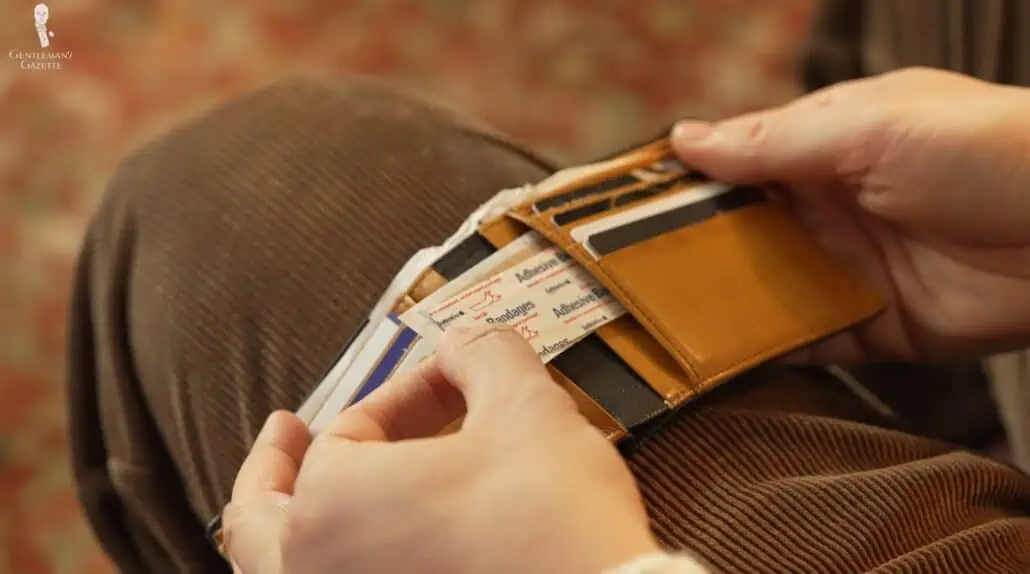
So, overall, I would argue a wallet is still essential in a gentleman’s wardrobe today. A really cool wallet can also exude elegance, luxury, and your personal style.
History of the Wallet
Some argue the origins of the word are derived from the old French term “gollette,” which means “little snout,” and I guess, you could argue it looks like one. Others say it’s derived from a Proto-Germanic word, which means as much as “to roll” because you used to roll up things in your wallet way back when it was first invented.
Actually, for most of its history, the term “wallet” referred to any type of leather bag or storage, not something that was just specifically for money. For instance, in William Shakespeare’s 1602 play “Troilus and Cressida,” one character remarks, “Time hath, my lord, a wallet at his back, wherein he puts alms for oblivion.” Yeah, that indicates that wallets look more like a knapsack rather than the wallet as we know it today.
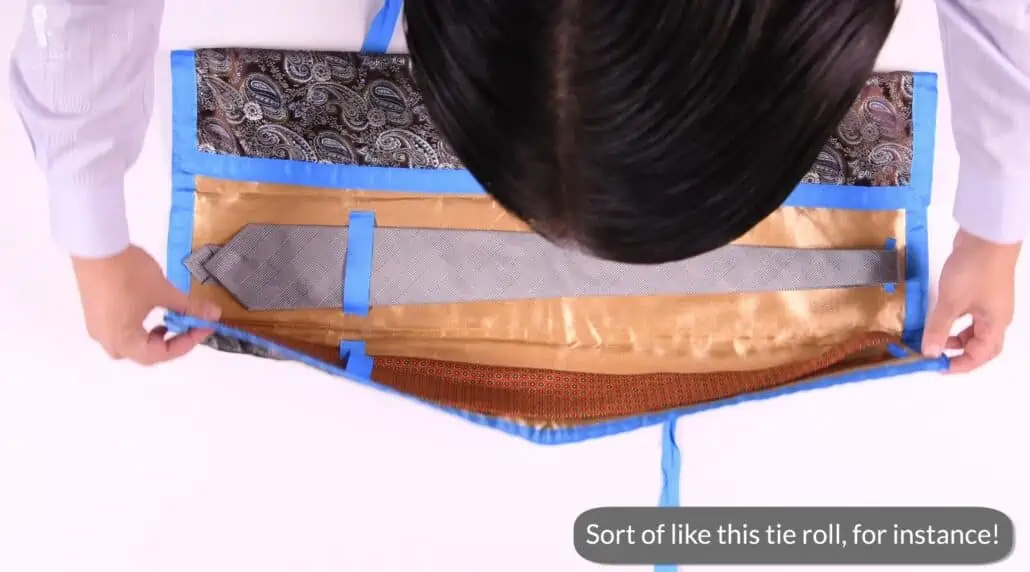
Actually, for most of human history, currency in the form of coins was usually transported in pouches or little purses or sacks or chests of little strings. In fact, it wasn’t until the late 17th century, when paper currency was introduced, that the wallet, as you know it today, took shape and form. And even then, up into the 19th century, a wallet was often used to refer to anything that you put something into. Just look at this late 19th-century version of the fly wallet, which was meant to keep flies for fishing.
Many wallets had special compartments for calling cards, there are little items, and even the shape of a wallet in the 18th and 19th century was quite varied. Some were made out of fabric with moiré, others had a frame or a strap. There was no common standard. Nevertheless, if you look at them, you’d probably say, “Yeah, that’s a wallet. Looks like one.”
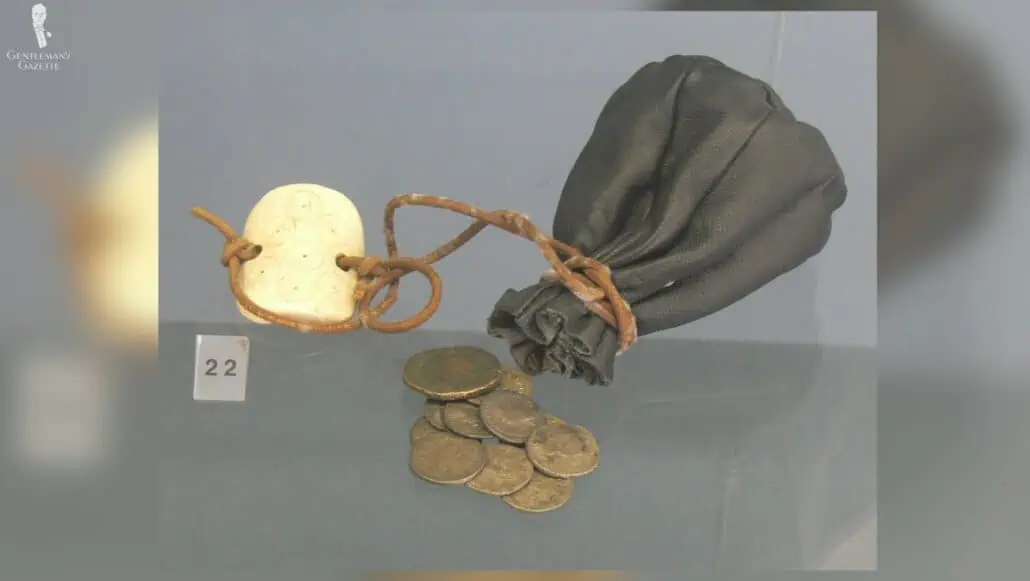
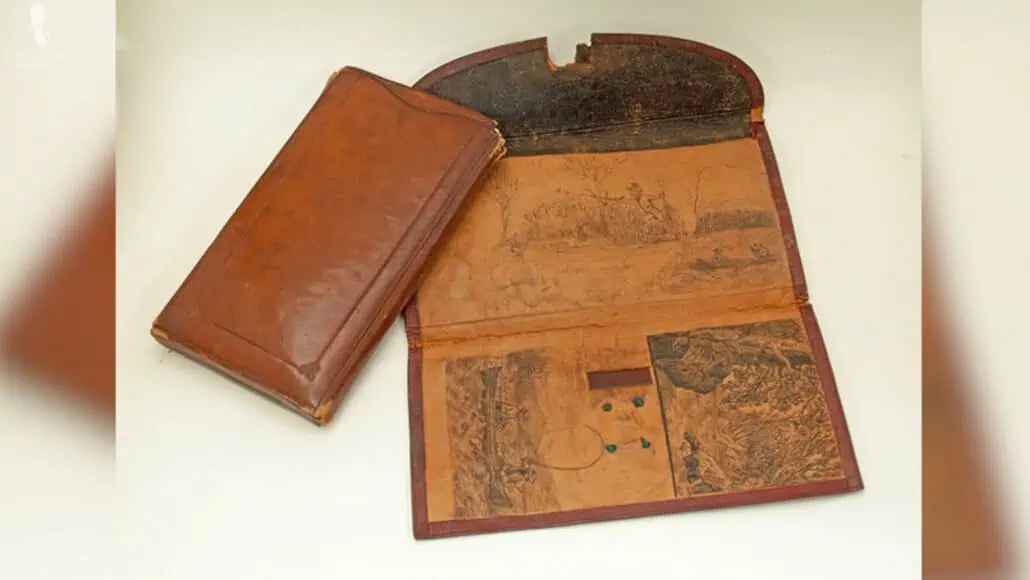
One of the popular wallets back then was the coat wallet, which was quite large, but why were they so big? First of all, wallets were typically carried on the interior pockets of a jacket, so they could be bigger and, on top of that, the paper currency was a lot larger.
For example, this one-pound note from 1805 was 200 by 113 millimeters long. That’s eight-by-four-and-a-half inches. Crazy, right? Compare this to the modern one-pound note, which is 135 millimeters by 67, so less than half of the size. That’s about five and one-fifth inches by two and three-quarter inches.
Now, in the early 20th century, men started moving their wallet from their inside chest pocket towards their trouser pockets. In order to make it fit and still wear comfortably, now, the wallets were folded in half and had a smaller footprint.
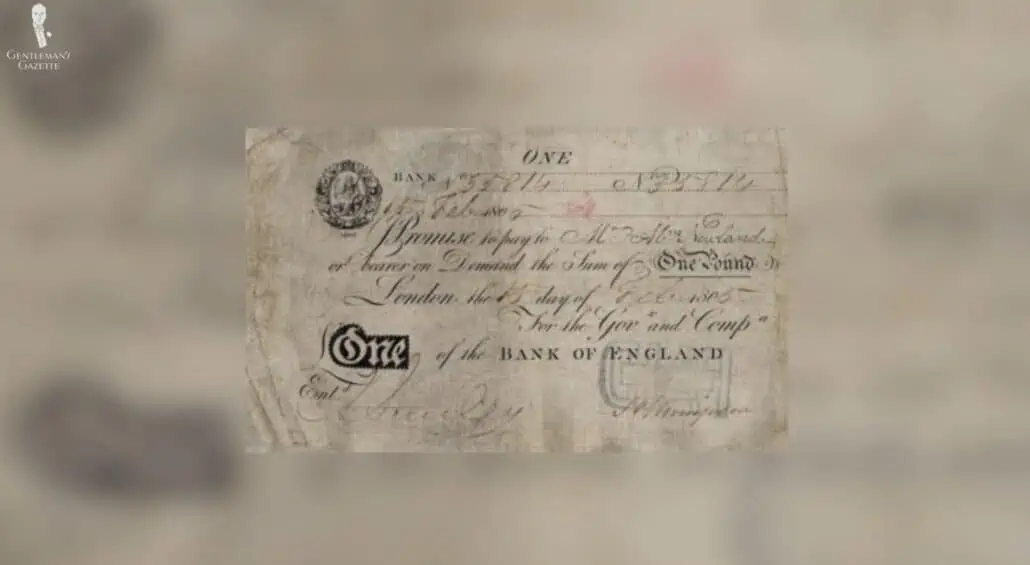
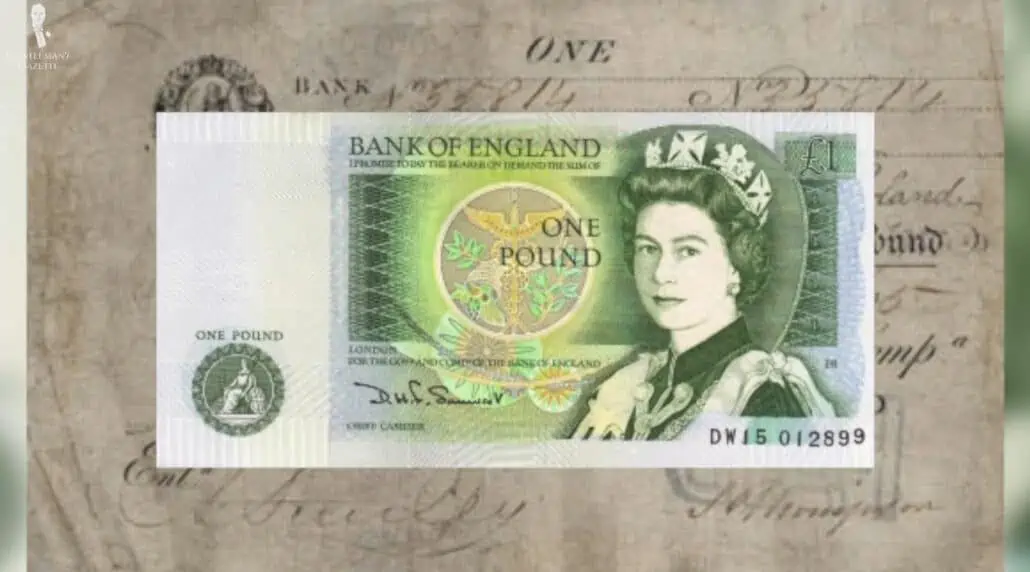
Coins were also more prevalent in most countries and so many wallets had coin pouches that were built-in at a time. In Germany, for example, today, a standard wallet still has a coin pouch versus, in the US, that’s not the case. I believe it’s because the lowest bill in the US is a one-dollar bill versus the lowest bill in Europe is a five euro bill.
With the rise of credit and debit cards a few decades ago, the billfold wallet had actual card slots because that’s what became most prevalent.
As the 20th century advanced, bigger coat wallets became less popular because fewer and fewer men wore jackets, and the regular wallet as we know it today became firmly established. While the actual wallet size shrank, what was in the wallet actually increased, leading, of course to, really overstuffed wallets.
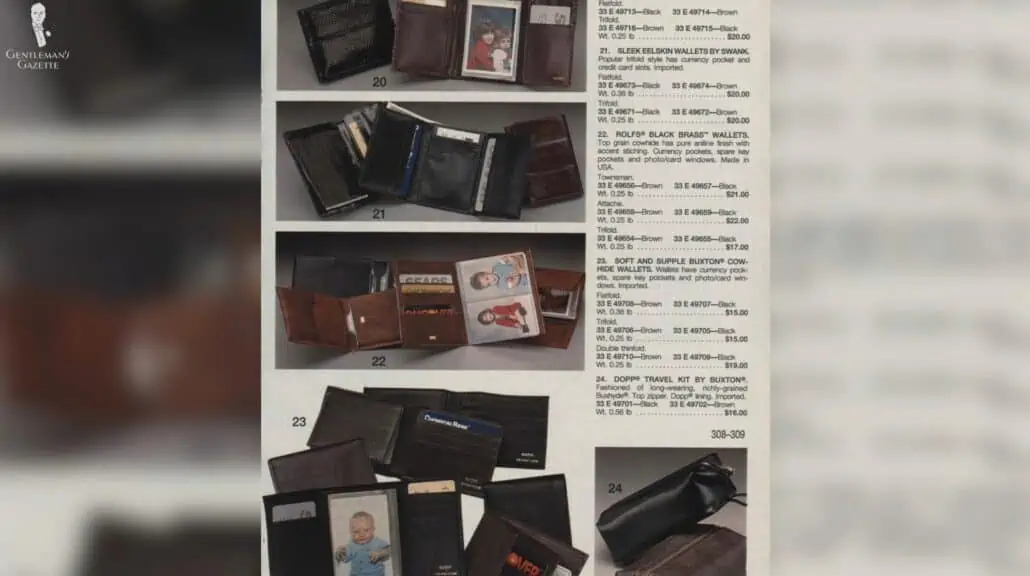
While leather was by far the most popular material for wallets. You also have poly alternatives on the market. Yes, can you believe it? A cheap vinyl wallet for a gentleman? But, in fact, some luxury brands use that for their goods.
In the 1990s, a lot of men were interested in really slim, minimalist wallets or something that didn’t take up much space, and so, money clips became more popular, especially in the US, even though they had been around for many decades prior.
In the last two decades, wallets have been made of more and more different materials – could be cork or vegan leather.
Wallet Types
There are many different types of wallets, each with its individual pros and cons. We’ll walk you through all of them and show you what to pay attention to when you’re investing money into your wallet.
If you go online or to a store, it seems like there’s an endless supply of different wallet styles and shapes. They’re all different in terms of functionality, comfort, and appearance, so let’s break it down into a few items, so it’s easier for you to find something that works for you.
1. Coat Wallet
First of all, there’s a traditional coat wallet. It has this kind of old-world style. You have lots of card slots. Oftentimes, the card slots are spaced wider, meaning it is flatter than a wallet where more cards are stacked in a smaller amount of space.
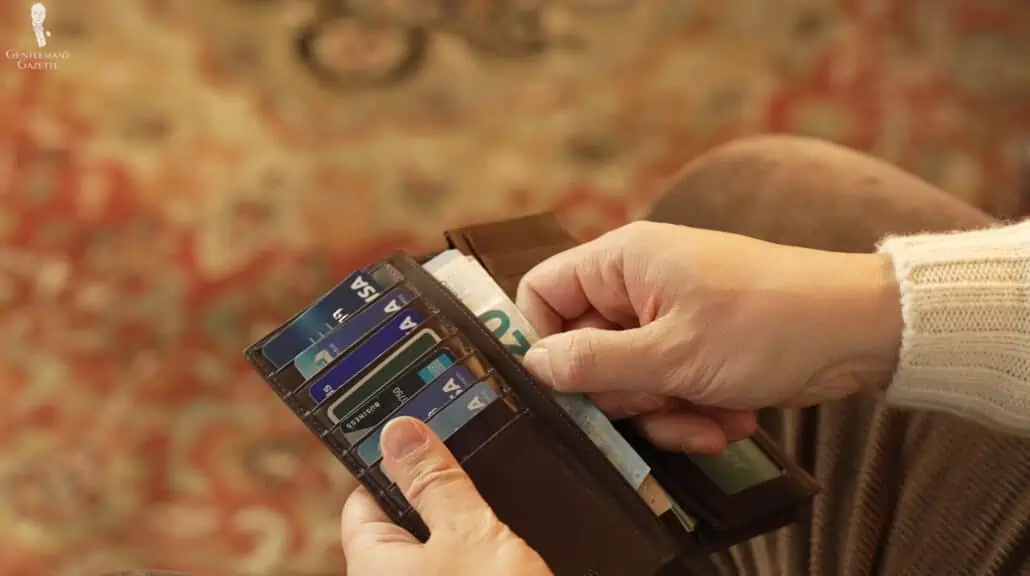
Some have vertical card slots, others have horizontal ones. Some have a section with just one row of card slots, others have double card slots. Typically, there’s lots of room for cash and other affirmatives in them, so it’s really the classic gentleman’s wallet that I recommend if you wear jackets regularly. It also works great for overcoats.
That being said, if you don’t wear a jacket or an overcoat, it’s quite cumbersome to remove all of your cards and put them into a smaller wallet. Because of that, I don’t think it’s super versatile in this day and age because hardly anyone will always wear a jacket.
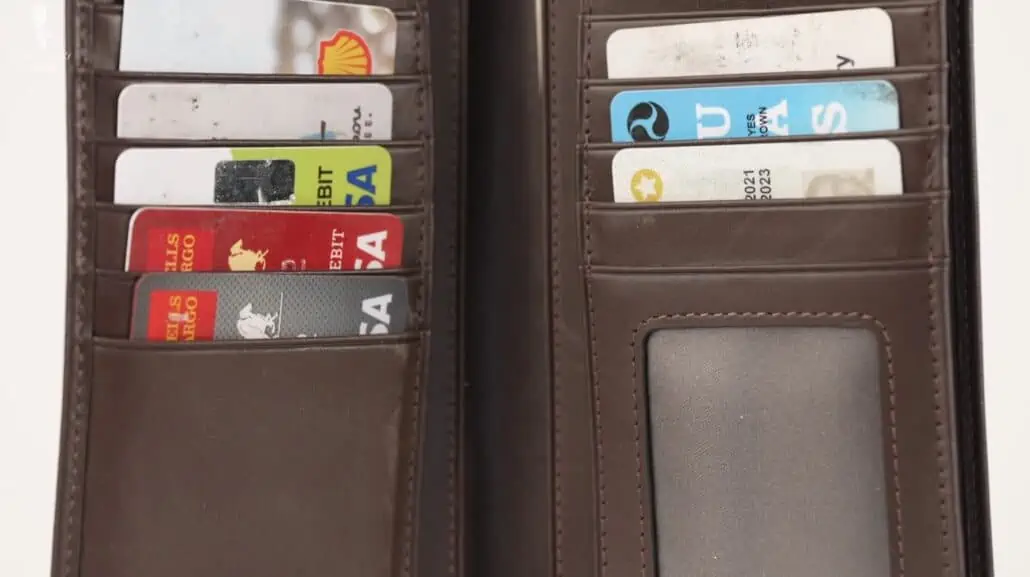
I myself, even at the Gentleman’s Gazette office, wear a sweater sometimes or a different kind of jacket that wouldn’t accommodate a coat wallet at all times.
2. Minimalist Wallet/Cardholder
So, the opposite of that coat wallet is the modern minimalist wallet-slash-card holder. It’s really designed to be on the opposite end of the spectrum and just hold your essentials.
Usually, you have two card slots on each side, sometimes they’re open in the middle or you have a rigid frame with certain buttons; if you push on them, the cards slide out in a showy way.

Typically, they’re designed to hold items securely, but it also means you could only have a limited amount of stuff or cards with you. Sometimes, they also have compartments that are really inaccessible, especially in the middle and so you never end up using them. Sometimes, they also have a money clip, but, otherwise, it can be painful to deal with cash with these small wallets. I think they’re ideal for times when you know you don’t have to carry cash and you just want really the bare basics with you.
I found, because those minimalist wallets have a very small footprint, every card that you have makes the thing wider and thicker. So, if you wear it in your jacket pocket, for example, or in your pants, it actually is quite noticeable because it stands out compared to a coat wallet where you can space out multiple cards over a larger surface area.
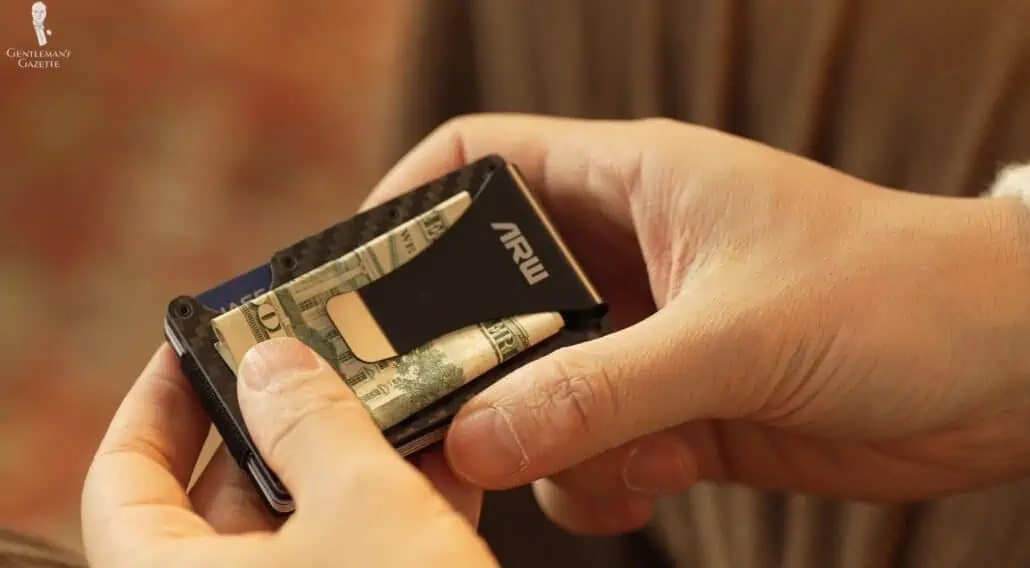
So, if you consider yourself a modern gentleman and you want something that has a more rugged appeal, maybe this is right for you. For the classic gentleman, I think it’s not the best choice.
3. Billfold Wallet
Introducing the billfold, the iconic modern wallet that sits in between the coat wallet and the minimalist one. It derives its name from folding the builds and you can have a bifold or a trifold. But, most of them are bi-folds.
Even if you don’t fold any bills anymore because you don’t carry cash with you, it’s still called a “billfold.” Again, some of them have coin compartments, others don’t.
At Fort Belvedere, we have no coin compartment. We just have card slots and then dividers. So, maybe you carry different currencies with you or you want one compartment for receipts and one for cash, whatever you need to make it very efficient and organized for you.
4. Case/Pouch Wallet
Apart from the billfold wallet, there is also a case wallet. Oftentimes, there can be zippered wallets or something that’s designed to really cover everything that’s inside much better than, let’s say, a billfold, which is open on one side.
Pouch wallets are typically popular with people who travel a lot and want to keep things safe. Often, they’re soft and contain a zipper. But, in everyday life for a gentleman, it’s not really a great look.
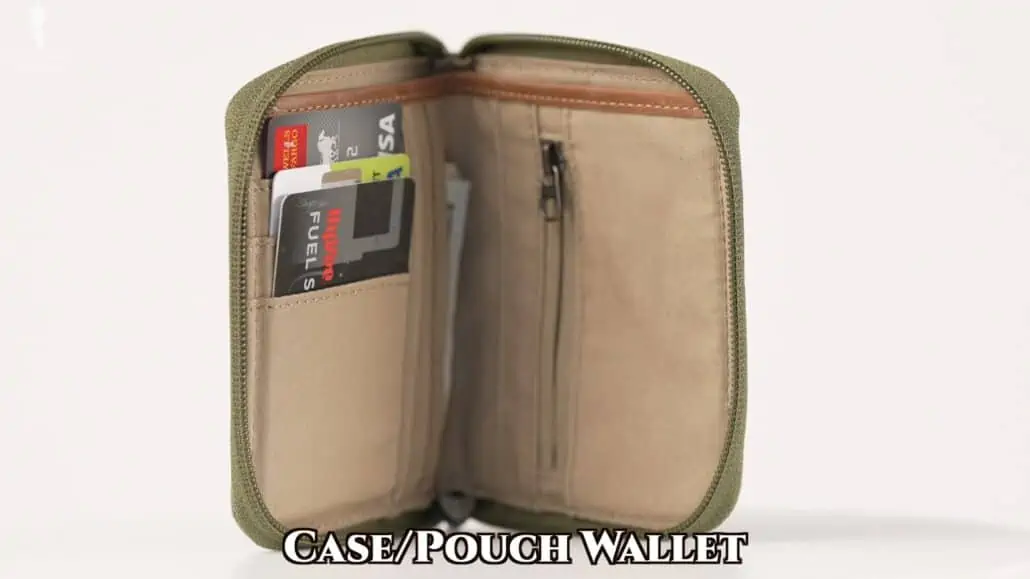
There are also rigid wallets, which are more like a business card case that are just a stiff frame. Sometimes, I’ve even seen people using things like a cigarette case as a wallet because it’s also very stiff, you can open it, it folds. So, whatever works for you, just give it a try and see if it works with your style and the functionality you need, and the way it looks.
When I first met my wife, Teresa, she had an old cigarette wallet, and I’ve definitely seen people who use our Fort Belvedere business card holders as wallets.
Yes, I know, in this day and age, business cards are not essential anymore at all. But, if you present one that looks nice in a nice case, you just stand out from the crowd. Personally, I like the padding of the business card cases and it’s special and unique; it definitely makes you stand out from the crowd if you use it as a wallet.
On the flip side, it is not designed as a wallet, so it doesn’t have as many card slots. It isn’t really a good place to store anything like a band-aid or an SD card. So, just figure out what you need and what works for you.
5. Specialty and Travel Wallets
Of course, apart from those, there are other specialty wallets. Sometimes, they’re combined with a phone holder or there are travel wallets that have a zipper and you can attach it to your belt, for example, so you’re less likely to be pick-pocketed.
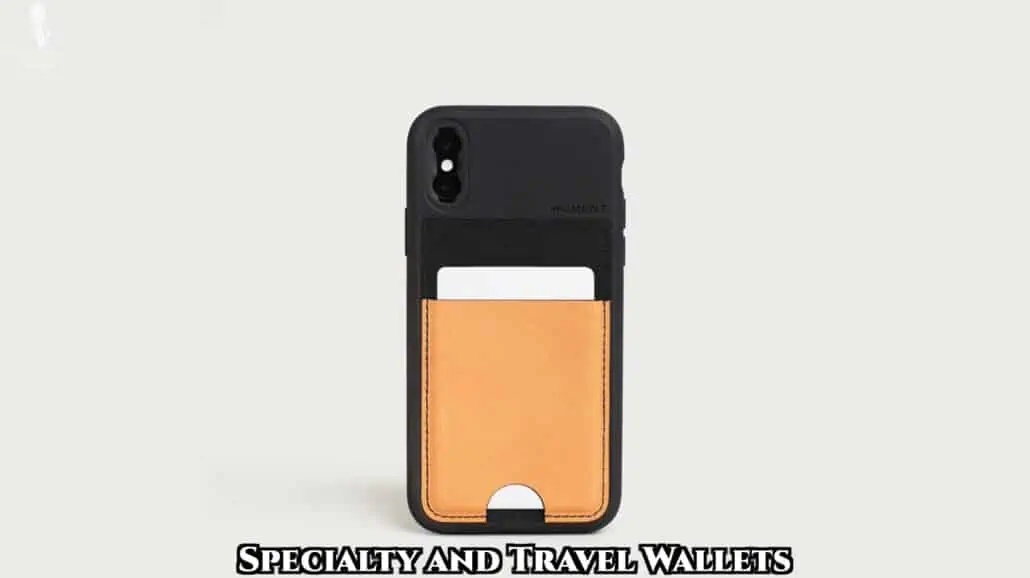
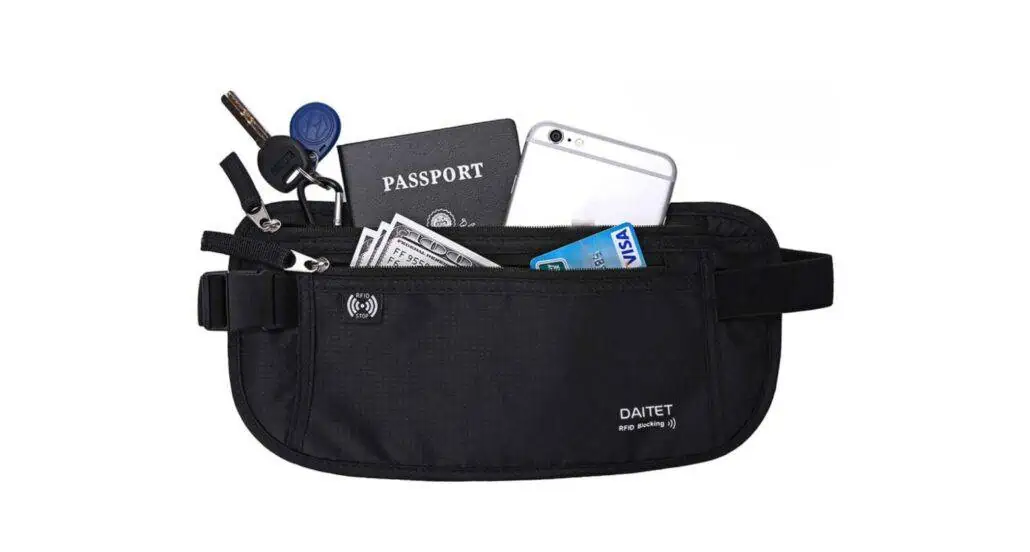
While many people think these so-called “travel wallets” are essential, it’s sometimes the thing that gives you away as a tourist.
Wallet Materials
No matter if you choose a coat wallet, a minimalist wallet, a billfold, a case wallet, or a specialty wallet. They will come in different materials. The most classic one is leather. However, you can find fabrics, vegan leather, acrylic, cork, and a bunch more. Lately, metal, carbon fiber, and I’ve even seen marble in wallets.
If you choose something rigid, it pretty much only works with a frame material with a very small footprint. Otherwise, it will look very odd and feel uncomfortable. Personally, most of these minimalist, modern, rigid wallets have a very futuristic appearance. They’re more sporty and rugged, but they don’t go at all and clash with a picture of the classic gentleman who wears a suit.
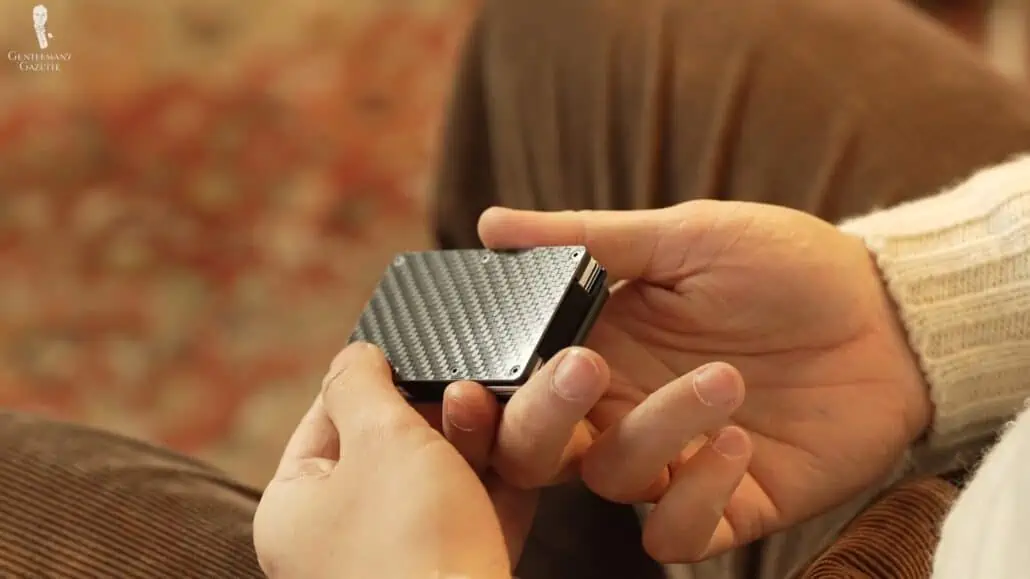
That being said, if you like something rigid, maybe repurpose your old cigarette case or something that you find and use that instead. Then, at least, stylistically, you’re in the same realm.
Since we’re the Gentleman’s Gazette here, I won’t discuss even plastic wallets because that’s simply not something you should ever wear.
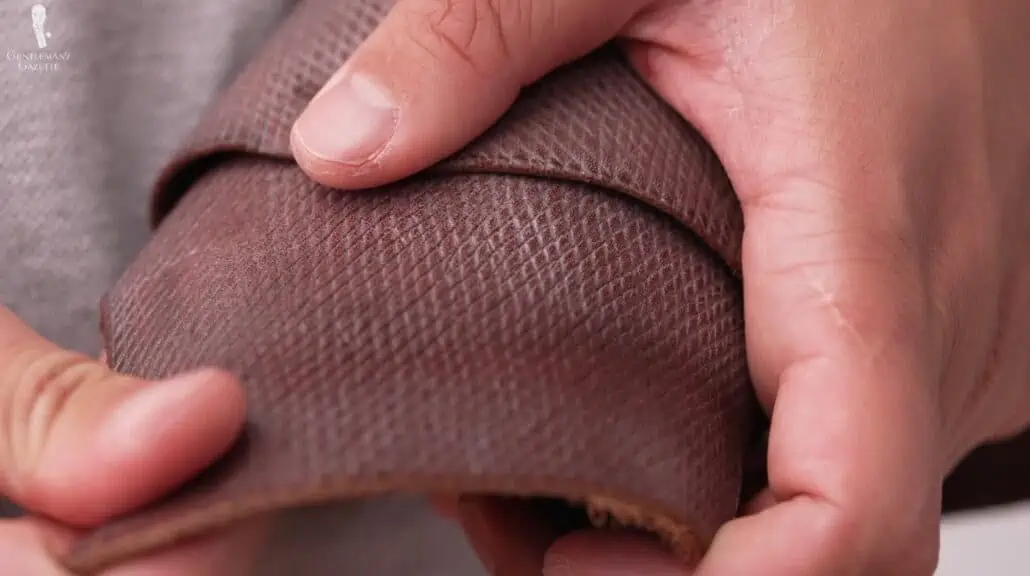
In my book, it’s hard to beat leather as a wallet material because it’s much more durable than fabric and, if it’s quality leather, it develops a nice patina over time.
As far as wallets are concerned, basically, the most luxurious options are exotic leathers such as ostrich or alligator or maybe fish leather, like salmon leather, or elephant. All of them are expensive and have a distinctive appearance that says, “Look at me. I can afford an expensive wallet.”
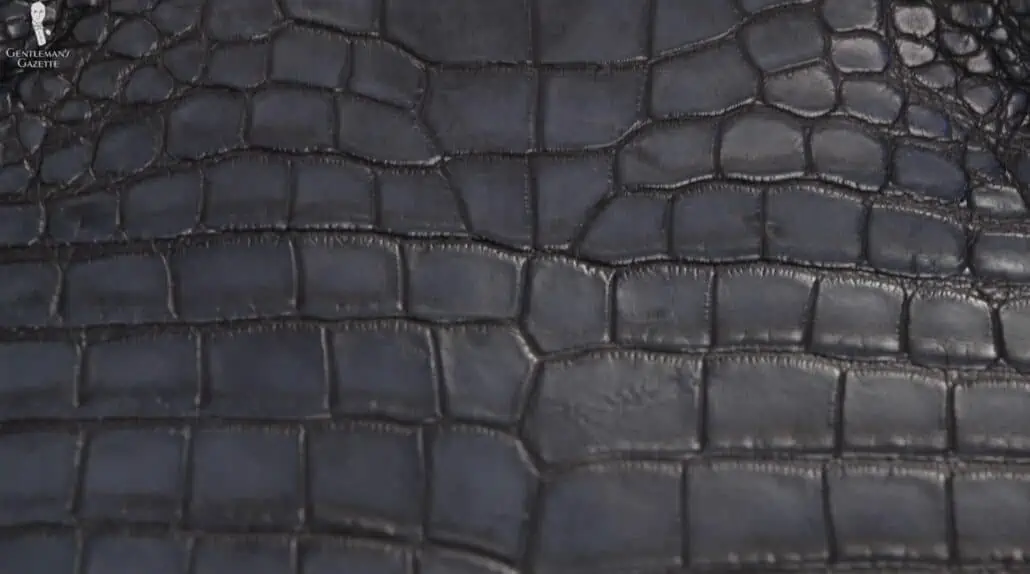
Deerskin is really nice for wallets because it’s soft, yet durable. So, you can have it in your pocket and it adjusts. It doesn’t crease in an awkward way and you will have it for years to come.
Cowhide is probably the most popular leather used for wallets and it’s relatively inexpensive. It’s widely available and it can be cut from large hides. Personally, I prefer box calf leather. It has a finer grain look. It comes from a smaller skin, but it’s still very durable. But, I find it typically thinner and just more elegant, and it’s the perfect choice for a gentleman’s wallet.
Not all box calf leather is alike. There is aniline-dyed leather, veg-tan leather, chrome-tanned leather.
The short answer is: you can find great chrome-tanned leathers and great veg-tan leathers. Typically, veg-tan may be a little stiffer, which, for a wallet, is not always ideal. It depends on your preference.
Also, not all box calf leathers are alike. Cows that come from the mountains like the Alps, where there’s fewer bugs, so you have fewer scars, which makes for a nicer-looking leather wallet.
You guessed it! At Fort Belvedere, we source leather from cows from the Alps, where they had few bug bites. So, you get the best look in your wallet.
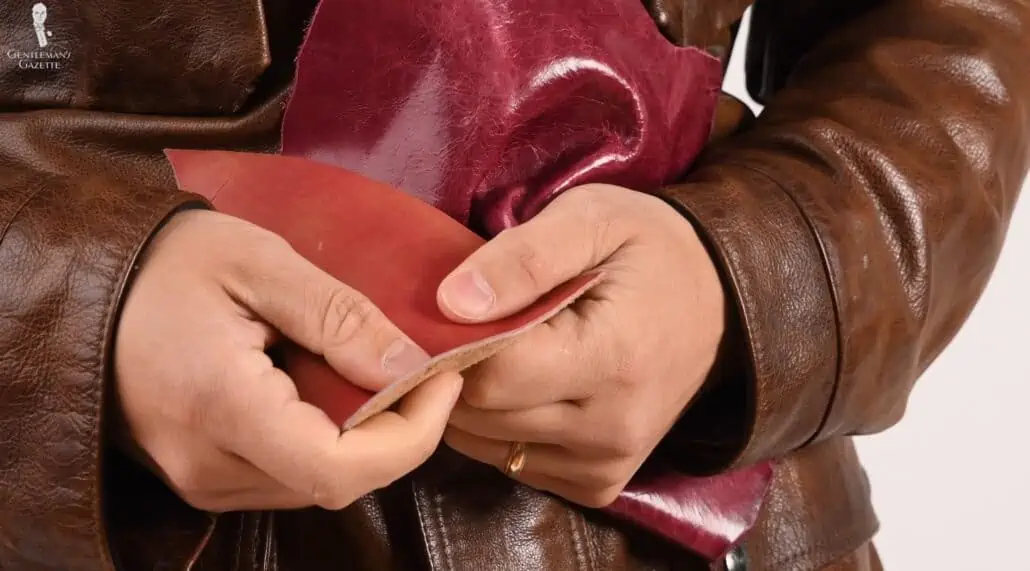
In terms of leather quality, there are huge differences. Oftentimes, things are advertised as “full-grain” or “top-grain,” but these are not protected terms and so, oftentimes, it can’t help you. Personally, I prefer leather that is never top-coated, meaning it is not sand-blasted off and it still has the original skin pores of the animal.
Sometimes, you have embossed leathers, where you still have that or you get a certain pattern, that is also okay in my mind. However, once you get to the point where you take layers of paint or color, typically, you’re trying to hide the inferior-quality hide or skin underneath of it.
Aniline-dyed is often used to highlight the quality of leather and, while most aniline leathers are actually of high quality, there are also non-aniline-dyed leathers that are also of high quality.
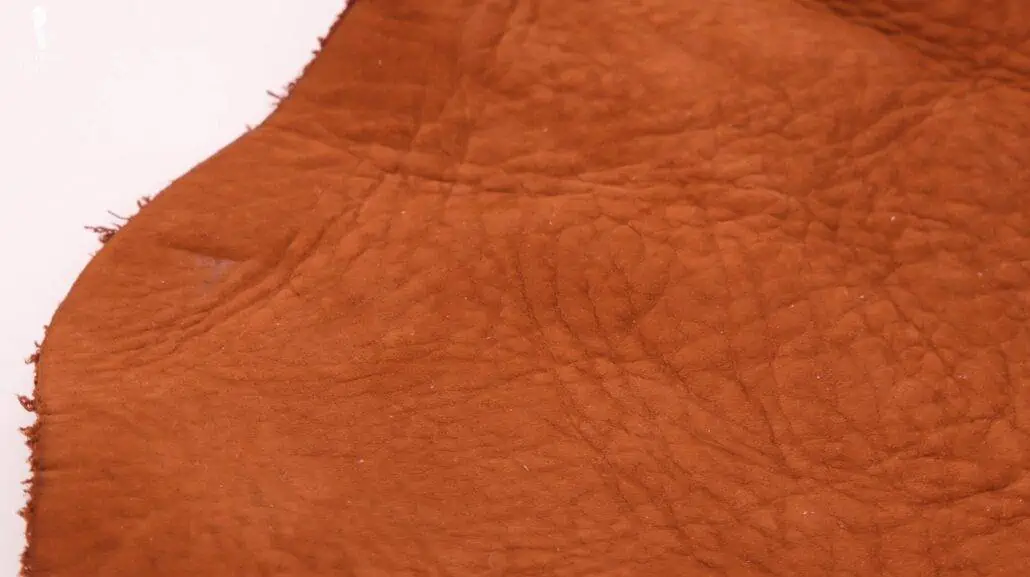
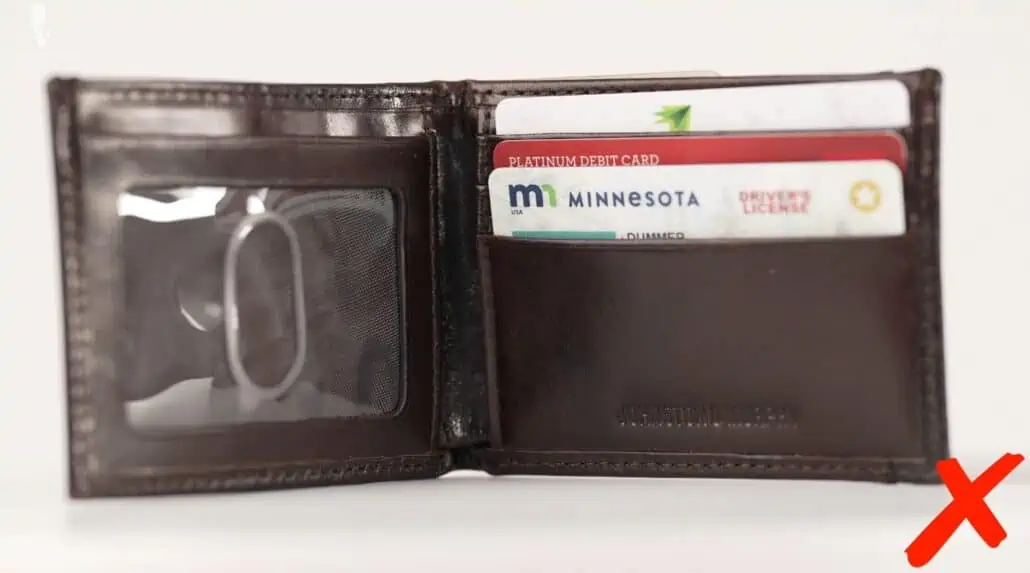
Especially for wallets, I always see that a lot of manufacturers use it on the outside, but they use less expensive, cheaper materials on the inside. Because I always disliked it, I wanted a wallet that was all made of leather.
And if you want to see how a Fort Belvedere pocket looks from the inside, check out our post on deconstructing our wallet.
Personally, another important aspect of a wallet is its thinness. Because I don’t want my wallet to really create this huge bulge, having something that, even empty, is slimmer is very important. Typically, leather is thicker than the thinnest fabric. But, when we designed our wallets, we really tried to make it as thin as possible while still making it long-lasting.
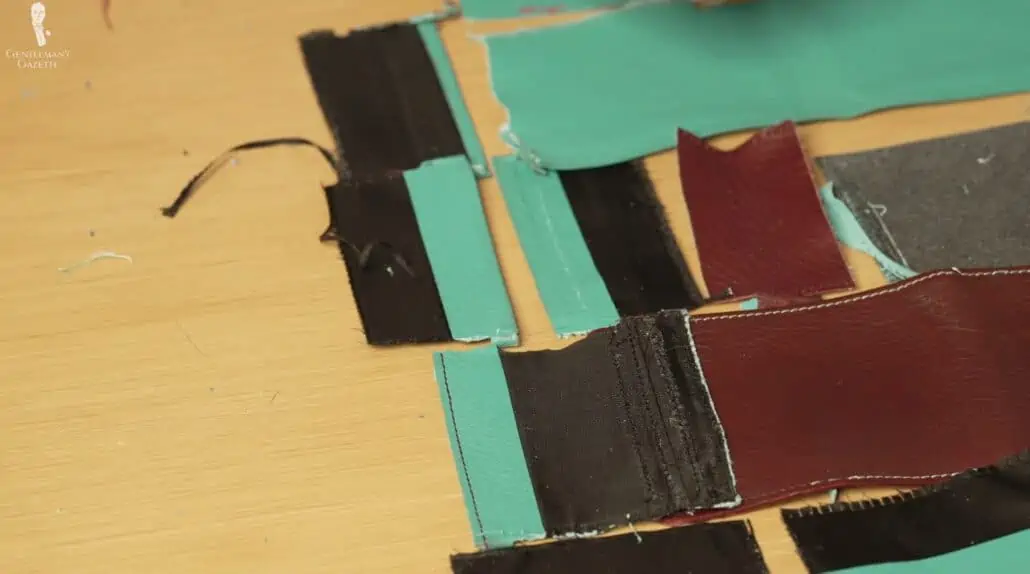
At the end of the day, what matters is how thick the wallet is when it has all the stuff in it that you want. And so, you have to see which size works for you.
Wallet Features & Construction Details
Some people love clear ID screens. Personally, I hate them. I don’t have to show my ID very often and I like the look of all leather over clear plastic.
You can also take a closer look at the details of your card slot for example. Some are just cut, others are constructed. It’s more durable and more elegant. Some edges are just simply folded once, so you can see the cut edge of the leather, others are folded twice and sewn in a way so you don’t see the cut edge of the leather, which means your wallet will likely last quite a bit longer and it looks much better.
Some wallets have really pointy corners, others are rounded, which is much better so don’t hurt yourself or rip a thread from your clothes for example. Even high-quality wallets can have cut, waxed, and edge-painted edges. I find the kind of quality level of workmanship on an artisanal level is definitely higher with double-folded edges.
One of the most common types of wallet wear is, typically, the corners and the area where you fold it because that gets creased a lot and so, if those areas are reinforced, your wallet will last longer. Sadly, you can typically not see from the outside what kind of reinforcements are inside of the walls.
Wallet Colors
Whenever I see wallets, they typically come in black or brown and that’s about it. Personally, I like to introduce color into my outfits – whether it’s through my accessories, like my pocket square or my cufflinks, my socks – but I also like to have them be reflected in my garment bag or, maybe, in my suitcase or my wallet. Aside from the much more debonair look, it’s always much easier to identify your wallet.
Let’s say, you’re at the TSA at the airport and you have to put your wallet through the scanner. When it comes out, you see right away which turquoise or burgundy wallet is yours rather than which black or brown one it is.
What Wallet is Best?
Well, unfortunately, there are so many in the market and we’ve tried quite a few for this guide. But, there’s a lot of change going on in the marketplace. So, rather than giving you specific recommendations, I urge you to learn about the quality of leather and, when you can identify that, you can find a wallet that will work for you because if you like something and if it’s really useful for you, you can probably decide best on your own.
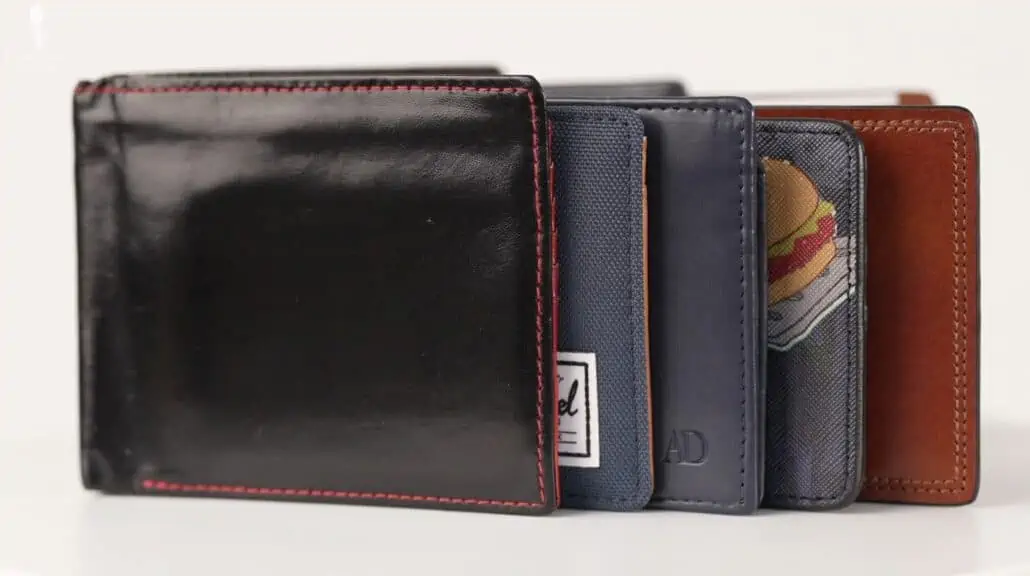
In any case, if you want to make something truly special or you want to give something as a gift, consider monogramming because it makes it less valuable for anyone else, but more valuable for the person who receives it.
How Much to Spend on a Wallet?
So, then, the question arises: how much should you spend on a wallet that is quality, that will last for a long time, and that you will enjoy for years to come?
I’d say cardholder wallets are probably in the $100-$250 range. Keep in mind, just because a wallet costs $100, doesn’t mean it’s automatically quality. Some of those brands really have a 90%-95% margin on them and they just spent a lot on marketing. That being said, a wallet for $15 will most likely not be of high quality.
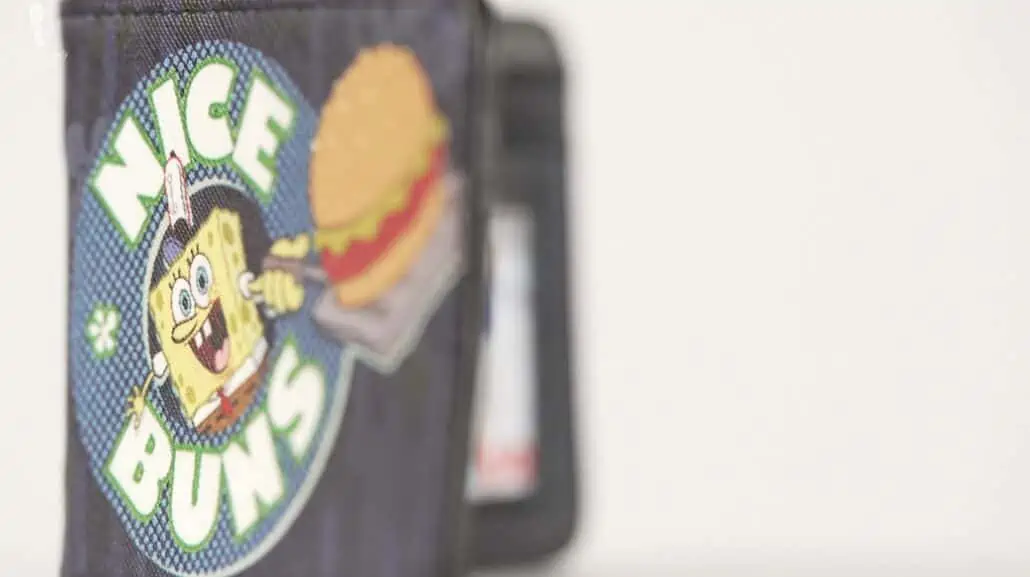
For a billfold wallet, I think if you stay between the $250 to $350 range, chances are you get something that’s really good. Coat wallets are bigger, they use more material, it takes longer to put them together, so they typically cost a bit more like $350 to $400.
And then, of course, if you have exotic leathers from a brand like Hermes, you will pay thousands of dollars. If you want maybe an exotic leather wallet that is made for you, you’ll spend quite a bit less. But, I’d say, at least plan between $500 to $1,000 for a regular billfold.
Conclusion
At the end of the day, you have to choose something that works for your budget and for your needs. Ideally, you want to choose a size, so you don’t have to overstuff it. Because then, any wallet, no matter how expensive, looks bad.
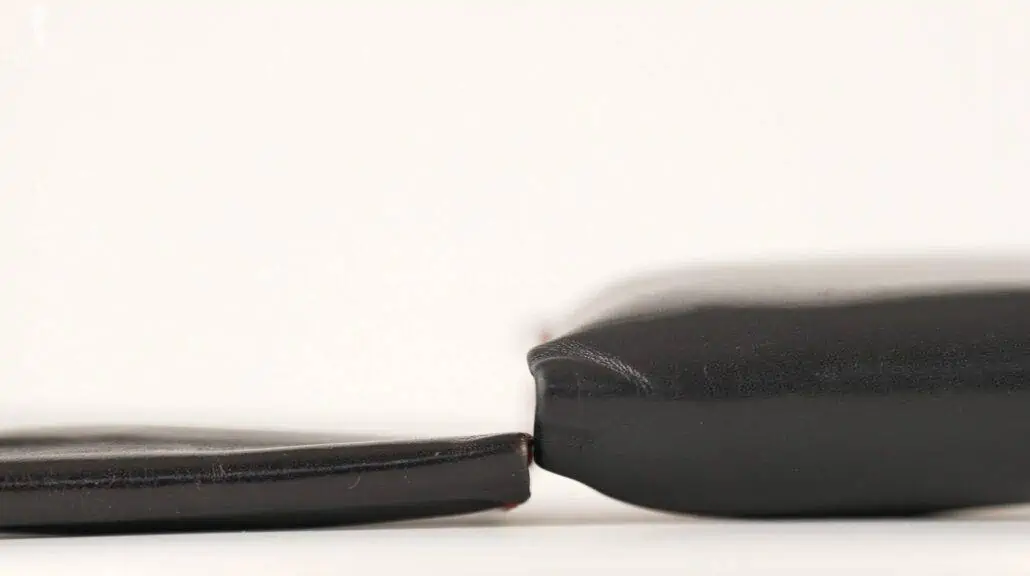
Outfit Rundown
Today, I’m wearing a casual, at-home outfit consisting of a red long-sleeve polo shirt paired with a tennis sweater that also has red and navy accents. My corduroys are brown from Polo Ralph Lauren.
My shoes are tassel loafers in a Prince of Wales check from Taft. My socks are red and off-white striped from Fort Belvedere. They pick up the color of the sweater, therefore, tying the outfit together, but still giving contrast to the shoes and the pants.
What about my wallet? Well, it’s still the original Fort Belvedere prototype, which is made of deerskin, that I’m wearing. I think it’s coming up on 10 years soon here and it’s still going strong. Just look at the corners and the areas where it’s folded a lot. Still pretty good. As you can see, the double compartment, the receipts in there, there’s cash in there, and it has served me well.
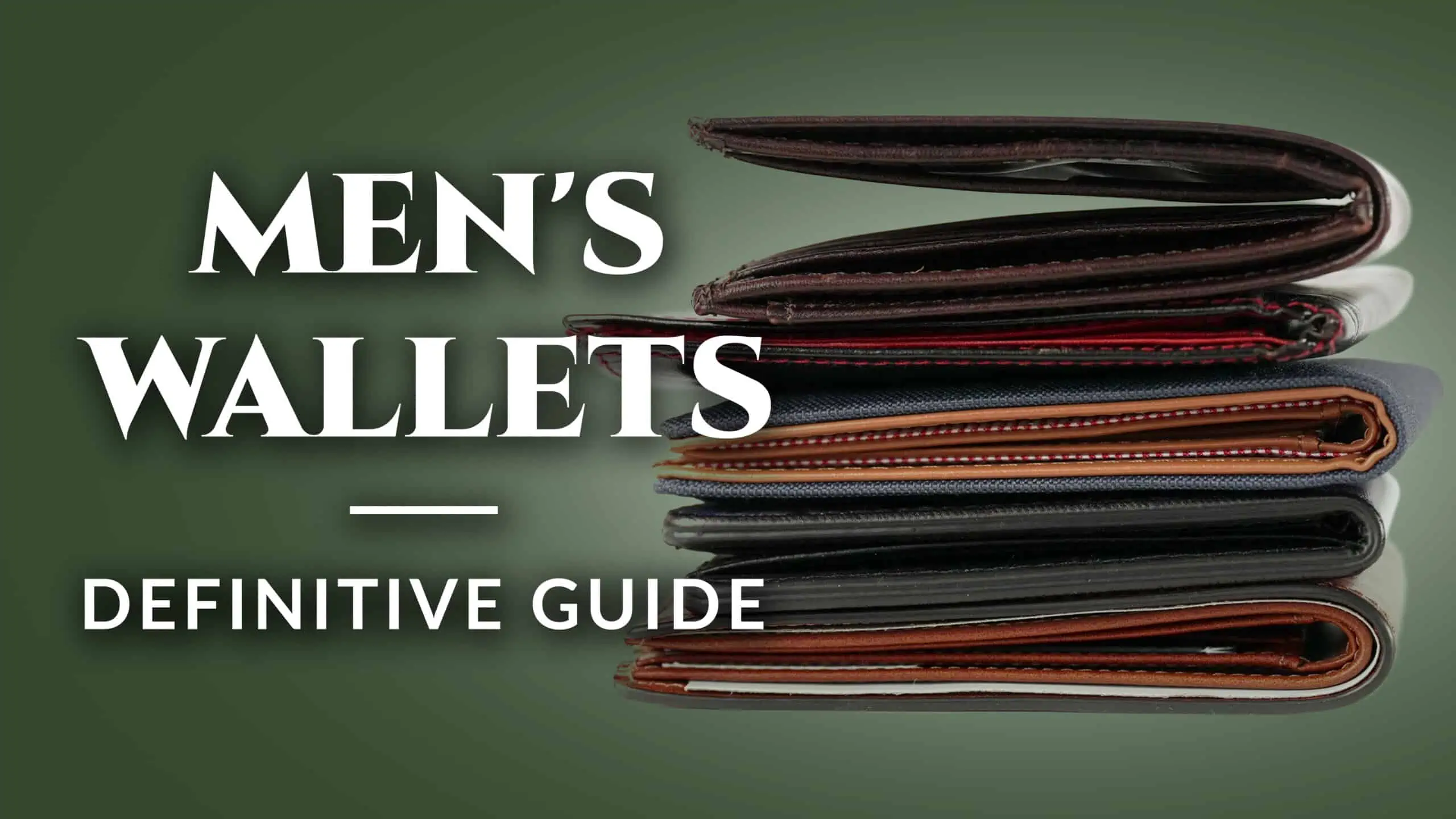
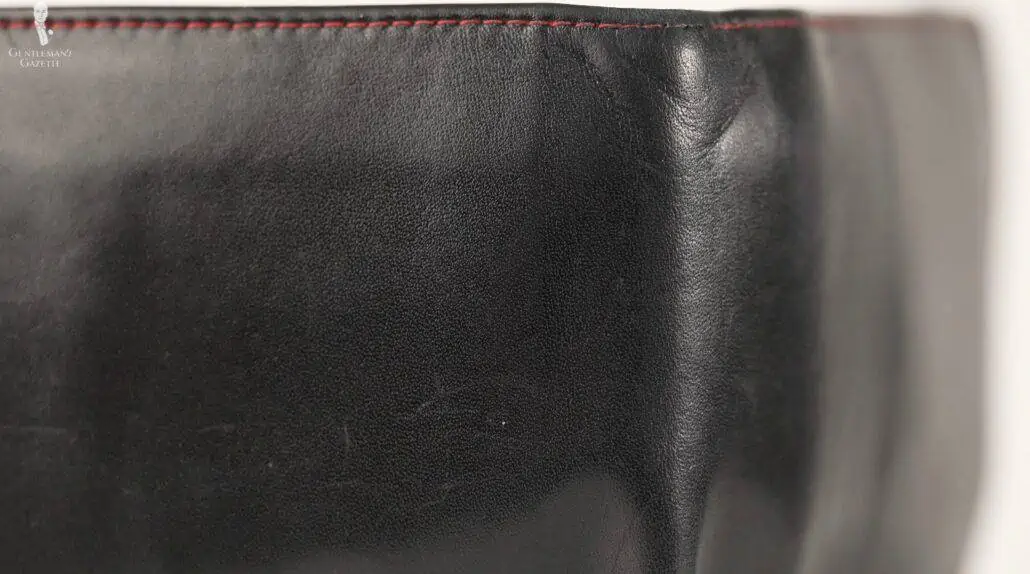
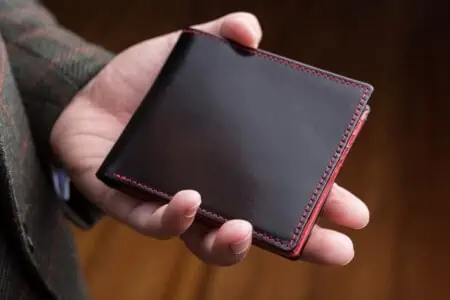
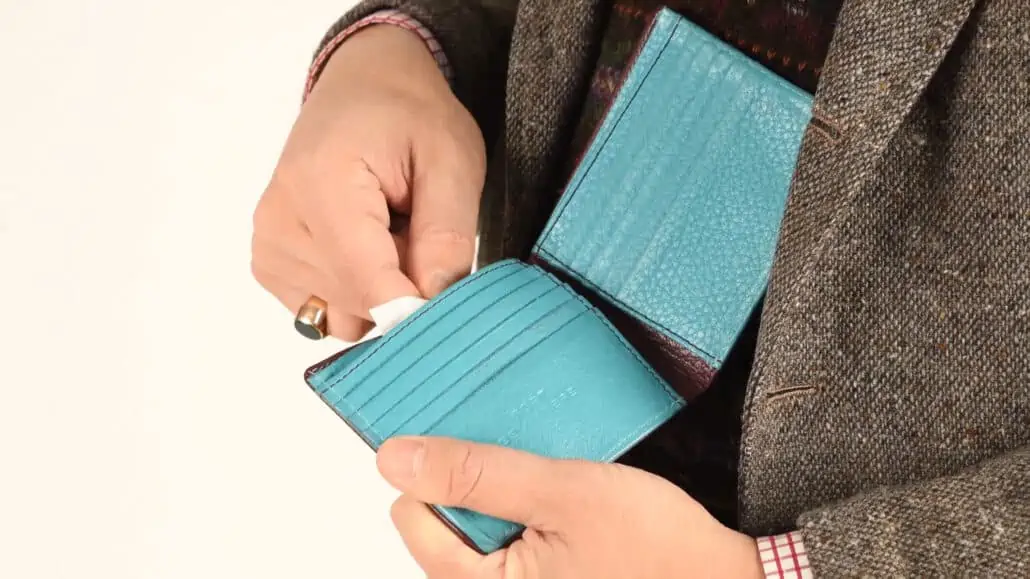
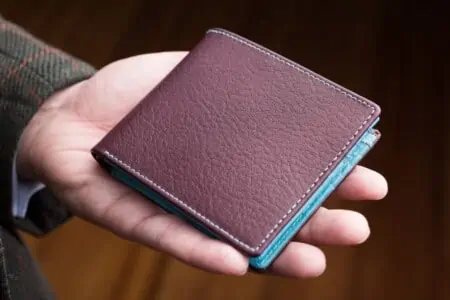
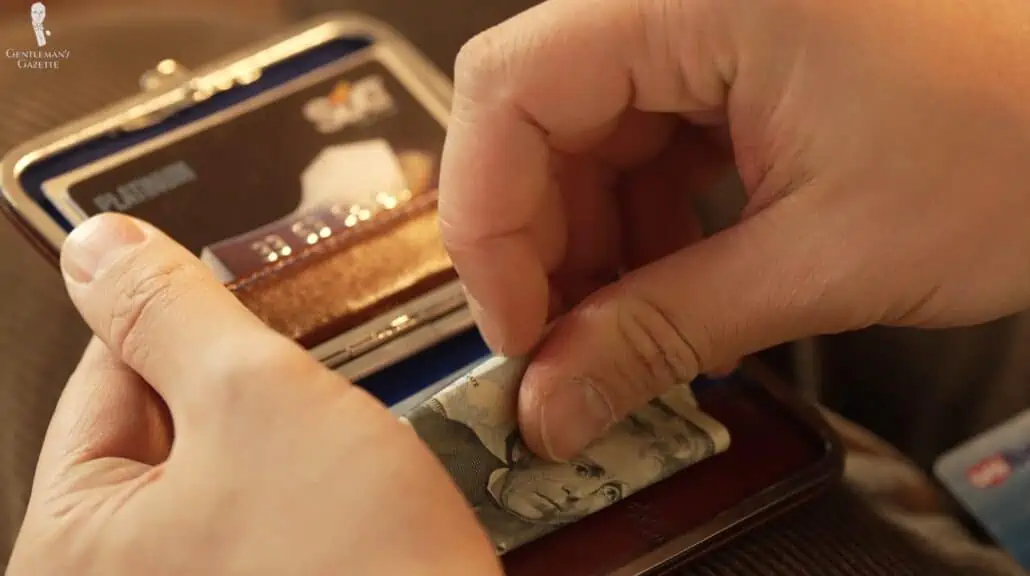
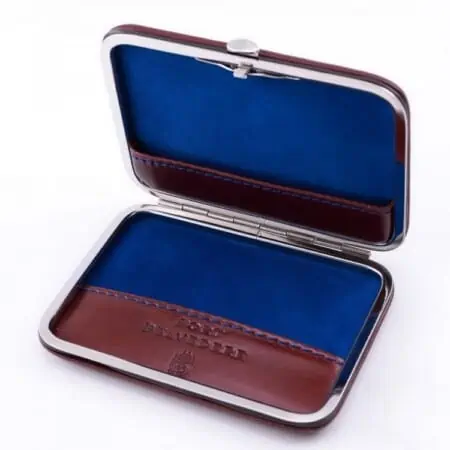
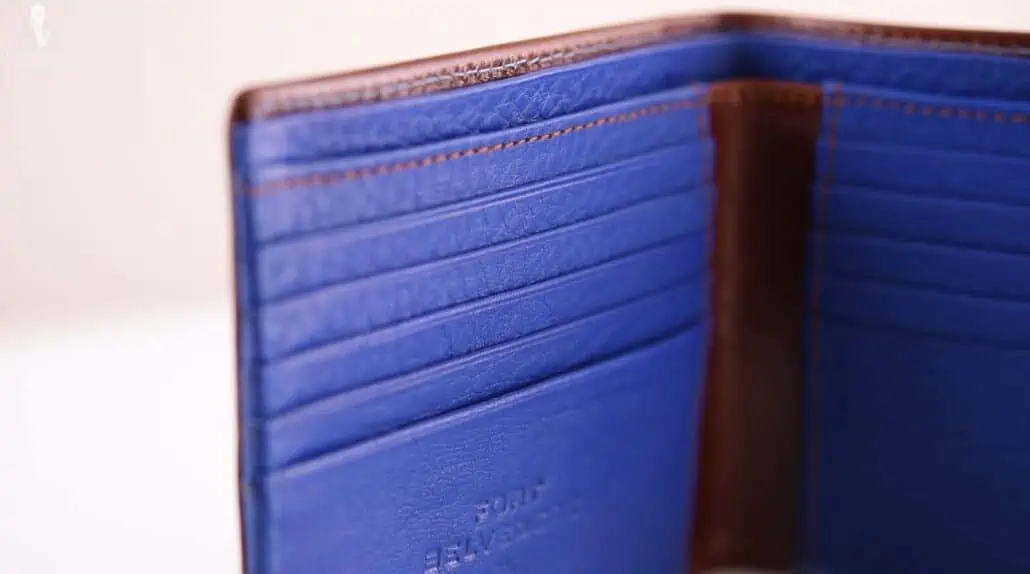
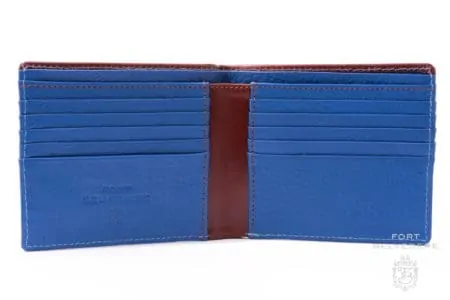
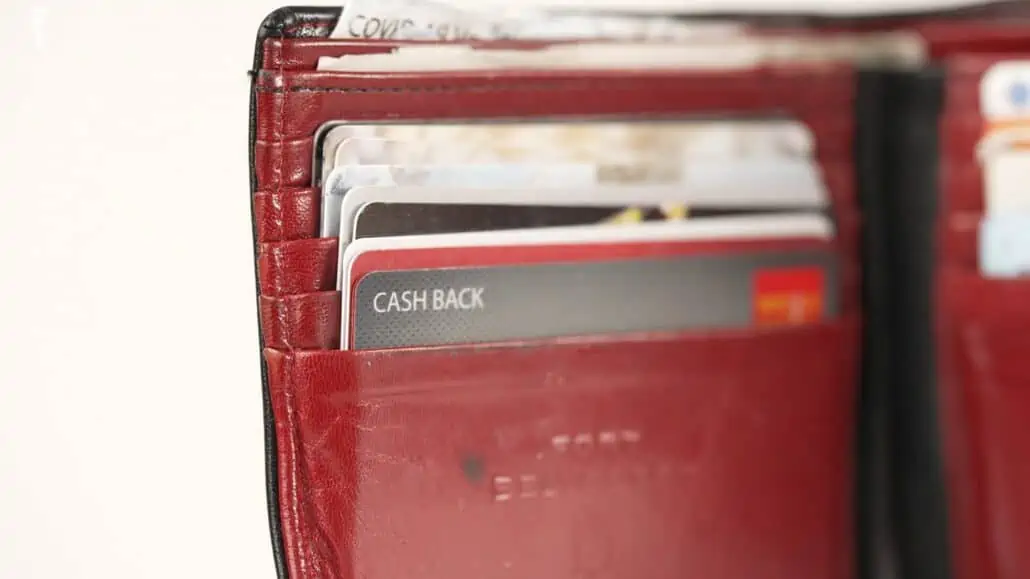
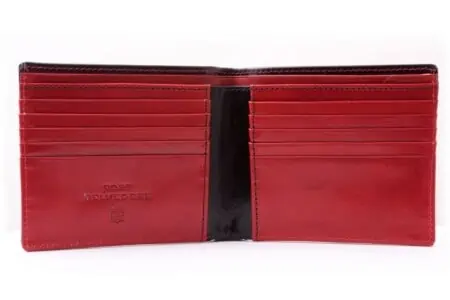
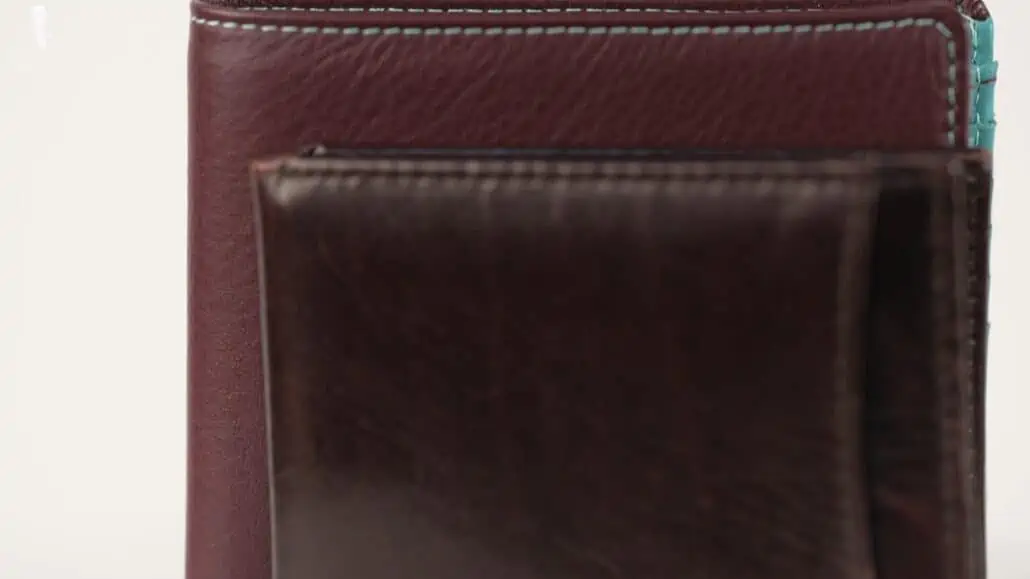
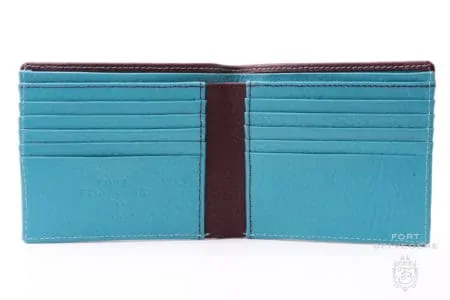
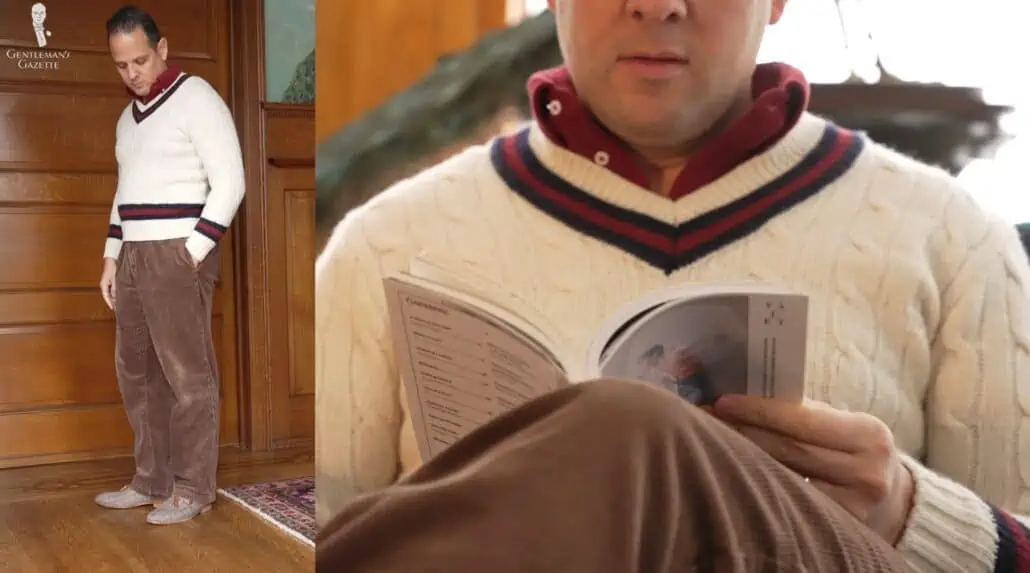
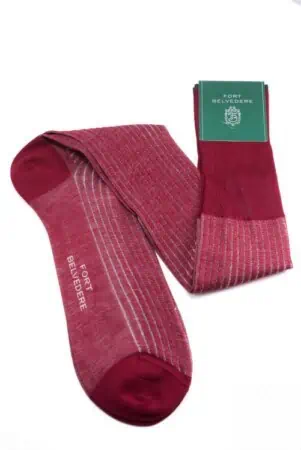
Best wallet is one with most cash inside it.
I used to have a Louis Vuitton coat wallet. I lost it twice in Manhattan and Queens before the BLM riots.
When I lost it in Manhattan, it was dropped off at the local police station. Cash, license and credit card all intact. When I lost it in Queens, I got my license mailed back to me. Typical.
I had a Mont Blanc money clip that I used after that but I literally wore out.
I had a black Lloyd Billfold in alligator with inner leather black Chèvre , black thread , black personalisation, blind embossing and internal note compartment divider in May 2021 from Equus Leather in England made.
It took seven months to make because of the pandemic. It cost me $1,300. I save 20% because they didn’t charge me the V.A.T.
Excellent wallet. Definitely an heirloom for my son.
I use a coat wallet as a checkbook wallet and keep seldom used identity cards in the slots. I picked up a second one just to keep all my casino rewards cards (and sports betting slips and related pocket litter. The everyday carry billfold keeps my regularly used credit cards, insurance IDs, and minimal cash. It also has a removable ID case so I can either flip up my drivers license or pull out my DL and and an aditional ID. For days when I know I am traveling light and dressing casual, I move a few important cards to a card holder and put my bills in a money clip. The “everyday billfold” is the default and the other options are for specfic purposes and outfits.
I carry a Fort Belvedere billfold, and it is absolutely on par with the best designer wallets. In fact, the quality is higher than most of them. The 2-tone color stands out.
I also have a specific billfold for travel to Europe. It is a 4-card Launer wallet with a snap-closure coin pouch, which is convenient for carrying €1 and €2 coins. 4 slots are fine because I only take cards that don’t charge a foreign transaction fee. Launer’s wallets are excellent and can also be had in two (or more) tone styles. I stick to two :-)
For foreign travel or if I am not wearing a coat, I find that a $30 Huskk leather card sleeve case is good enough. It will hold half a dozen cards and some cash and fit easily in a back pocket. A good quality wallet is nice to have but an encumbrance if you are in jeans and T-shirt.
Glad to hear you’re enjoying your Fort Belvedere wallet, James! Is it your everyday wallet?
You might want to look into N American elk hide. It is similar to deerskin but slightly thicker and much more durable.
If you haven’t already seen it, we have a video where Raphael discusses what goes into a Fort Belvedere wallet
I have used wallets by Louis Vuitton for years, and they are expensive, but hold up and look great.
Personally, I think that Launer wallets are the best you can buy. Mine has space for 16 cards and plenty of cash. Top quality leather that will never wear out.
Good and informative video! I feel impelled to ask why you say no one uses business cards?? Of course gentlemen in business use them! How can you say that? Other than that, it was an interesting article.
I use the grip6 wallet with brown leather and in my opinion it‘s perfect (may be not realy gentleman-like)